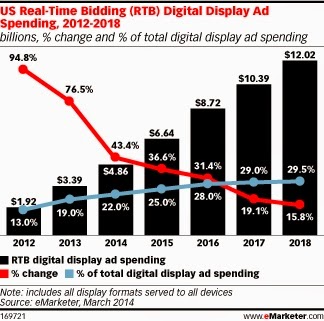The first thing you learn at business school is about "willing to pay (WTP)" of a consumer. The ultimate dream of any seller is to be able to price discriminate between consumers with different WTPs i.e. for the same product, the seller would want to higher charge a consumer with higher WTP and vice versa. The whole issue of morality comes into play when people hear about this price discrimination and everyone wants to pay a uniform price. The reality remains that supply and demand dictate the price in the market. Said another way, if I knew WTS and WTP, I could construct
supply and demand curves and predict the market outcomes accurately.
The dynamics of a perfect Supply and Demand (S&D) are definitely in play in the online advertising space as well. Given that the online advertisers (the buyers) wont themselves reveal their WTP to the publishers (the suppliers), the bigger suppliers in the market setup these market places where the buyer bids for the ad inventory and hence signals his WTP. A big chunk (about 22% in 2014) of the online ad spending revenue now comes from Real-time Bidding (RTB).
The RTB inventory is traded through exchanges. These market places use what is known as the second-price sealed bid auction (a.k.a the Vickery Auction). In theory, Vickey auction ensures that the consumer always bids at his or her WTP. At his WTP, the payoff to the buyers is his WTP minus the second highest bidder's WTP.
The publishers in online advertising are often up in arms about price opacity of the online advertising inventory. The publishers point of view is that the consumers are willing to pay higher for their inventory but the design of the RTB market results in lesser revenue for them. So what are the alternatives to Vickery auction?
English Auction
In the English auction, the highest bidder wins - think eBay. The outcome (winner and payment) is the same whether we use an English auction or a Vickrey auction.
In the First Price Auction, winner pays their own bid. Surely, this sounds like the auction that publishers want. The problem in this approach is that the buyer's tend to shade their bids i.e. that they don't bid their own WTP. If buyers don't shade their bids, their payoff will be zero (read buyer's curse). Econ 101 goes into details around how much buyer's should shade their bid to preserve their payoff.
So what should the publishers really do? Its not really a completely doom and gloom situation for the publishers. There are some products out there which try to bring transparency to publishers into the online market space.
To conclude, the online ad publishers (like any other seller) will not be able to extract 100% WTP of the marketers in any auction format. That's how every business works and publishers are no exception!
supply and demand curves and predict the market outcomes accurately.
The dynamics of a perfect Supply and Demand (S&D) are definitely in play in the online advertising space as well. Given that the online advertisers (the buyers) wont themselves reveal their WTP to the publishers (the suppliers), the bigger suppliers in the market setup these market places where the buyer bids for the ad inventory and hence signals his WTP. A big chunk (about 22% in 2014) of the online ad spending revenue now comes from Real-time Bidding (RTB).
The RTB inventory is traded through exchanges. These market places use what is known as the second-price sealed bid auction (a.k.a the Vickery Auction). In theory, Vickey auction ensures that the consumer always bids at his or her WTP. At his WTP, the payoff to the buyers is his WTP minus the second highest bidder's WTP.
The publishers in online advertising are often up in arms about price opacity of the online advertising inventory. The publishers point of view is that the consumers are willing to pay higher for their inventory but the design of the RTB market results in lesser revenue for them. So what are the alternatives to Vickery auction?
English Auction
In the English auction, the highest bidder wins - think eBay. The outcome (winner and payment) is the same whether we use an English auction or a Vickrey auction.
- Vickrey
- Each bidder bids his/her WTP
- Winner = the bidder with highest WTP
- Payment to publisher = second-highest WPT
- English:
- Each bidder drops out when the current bid hits his/her WTP
- Winner = the bidder with highest WTP
- Payment to publisher = second-highest WPT
In the First Price Auction, winner pays their own bid. Surely, this sounds like the auction that publishers want. The problem in this approach is that the buyer's tend to shade their bids i.e. that they don't bid their own WTP. If buyers don't shade their bids, their payoff will be zero (read buyer's curse). Econ 101 goes into details around how much buyer's should shade their bid to preserve their payoff.
So what should the publishers really do? Its not really a completely doom and gloom situation for the publishers. There are some products out there which try to bring transparency to publishers into the online market space.
To conclude, the online ad publishers (like any other seller) will not be able to extract 100% WTP of the marketers in any auction format. That's how every business works and publishers are no exception!

No comments:
Post a Comment